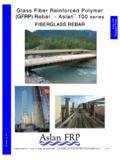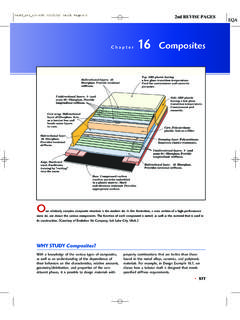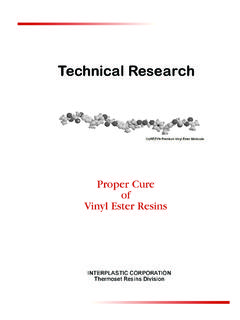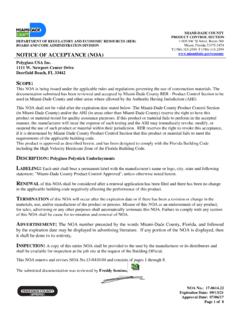Transcription of INSTALLATION GUIDE - Fiberglass Reinforced …
1 Surface systemsStyled & Durablesurface systemsINSTALLATION GUIDEGLASBORD | DESIGNS | VARIETEX | KEMPLY wall, ceiling and laminated panel installationTOPICSG eneral Information 3 Safety Precautions, Supplies, Equipment and Storage InformationInstallation Preparation 4 Wall Preparation, Choose an Adhesive, Environmental ConsiderationsPre- INSTALLATION Planning 6 FRP with Performance and PresenceBasic FRP INSTALLATION Steps 6 Cutting Instructions 6 Attaching to Wall 7 Adhesive, Spacing, Panel Sequence, Panel FinishingSeam Treatment Options 8 Moldings, Color Coordinating Caulk, Fasteners, Seam SealantSpecialty Installations 13 Ceiling panels , Car Washes, Laminated PanelsDISCLAIMER PLEASE READ ALL INSTRUCTIONS BEFORE BEGINNING INSTALLATIONT hese guidelines are provided in good faith to help prevent INSTALLATION problems caused by common errors.
2 The manufacturer and/or distributor of the product bears no responsibility for INSTALLATION actions taken or not taken. There are many nuances of INSTALLATION that are assumed to be general construction knowledge to an experienced installer; such nuances are not included in these instructions. Rather, these INSTALLATION guidelines are strictly recommendations and are not intended to serve as a step-by-step, foolproof INSTALLATION checklist. Selection of an experienced FRP installer is the sole responsibility of the project owner and architect. Crane Composites does not accept any responsibility for job failure resulting from or associated with improper job site environmental OUR MOST CURRENT SDS AT PRIOR TO WORKING WITH OUR PRODUCTS FACTORY MUTUAL APPROVAL Fire-X Glasbord (FXE and FSFM) is the only Fiberglass Reinforced interior wall and ceiling panel that is accepted under Factory Mutual Research approved FRP, Plastic Interior Finish Materials when installed in accordance with Factory Mutual Research Approval Standard 4880.
3 This information is available at and NOTE: Please contact your local FM Global Representative to provide a field exemption of alternative methods of guideGENERAL INFORMATION Safety Information WHEN CUTTING OR DRILLING, ALWAYS WEAR PROTECTIVE GLASSES OR GOGGLES AND A FACE MASK WHICH COVERS THE FACE AND MOUTH. Itching due to glass fibers may be avoided by the use of barrier creams on exposed skin areas. Hearing protection is also and EquipmentSupplies will vary depending on wall substrate, adhesive choice and seam treatment FRP TOOLS NEEDED Crane Composites Laminate Roller (Part # R50 ROLLER) Crane Composites V-notched Trowel 3/16 x 1/4 x 5/16 (Part # R50 TROWEL) Circular saw with fine tooth carbide tipped saw blade Swivel-head 18 gauge shears Drywall Roto-Zip Jig-Saw Flat edge finishing tool (putty knife or equivalent) MATERIALS NEEDED Crane Composites FRP panels Adhesive - Crane Advanced Polymer Adhesive (R53829) or Crane Fast Grab Adhesive (R53828)Refer to page 5 for assistance in selecting the appropriate adhesive Soap and water for clean-up (Latex or Polymer adhesives)
4 Saw horses Plywood larger than panels Dry, lint free rags Sandpaper or Paper Tiger Wallpaper Removal Tool for roughing up wall Tape measure Utility knife Six-penny finishing nails Carbide tipped laminate cutter IMPORTANT NOTE: If INSTALLATION room has high humidity (65% or higher) then a portable low-cost dehumidifier unit is TREATMENT Moldings Color Coordinating Caulk Seam Sealant (cleanroom only) Cleanroom Wall System Seam Sealant - 7555 Urethane Sealant (R53827) Applicator - Pneumatic Dual Chamber Applicator Gun (R50 CAULKGUN) 400ml Static Mixing Tips - 3/8 x 11 x 24 EL Finishing Kit - Inline Seam and Radial Seam Finishers for seam smoothing (R50 SEAM-KIT) Painter sl Tape (minimum 1 wide) Solvent for clean-up (IPA, acetone) Protective gloves needed when using seam sealantStoragePanels should be stored indoors on a solid, flat, dry surface other than the floor.
5 Do not stack on concrete floor or any other surface that emits moisture. Lay panels flat with proper support on the ends of panels . Do not stand panels on edge. All FRP panels must be stored inside. Optimum storage conditions are 60 to 75 (16 C to 24 C) and 35% to 55% relative humidity (Figure 1).FIGURE 13 INSTALLATION PREPARATIONPre-ConditioningBefore beginning the INSTALLATION , the installer must determine that the environment of the jobsite meets or exceeds all requirements specified in the INSTALLATION GUIDE . Prior to installing, remove the packaging and allow the panels to acclimate to the room temperature and humidity for 24 hours. Acclimation temperature range should be 60 F to 75 F (16 C to 24 C) and relative humidity should be 35% to 55%. Ideally, both the room temperature and humidity during acclimation and INSTALLATION should be the same as the final operating ConditionsInstallation should not begin until building is enclosed (windows and doors are installed), permanent heating and cooling equipment is in operation, and residual moisture from plaster, concrete, or terrazzo work has dissipated.
6 INSTALLATION temperature range should be 60 F to 75 F (16 C to 24 C) and relative humidity range should be 35% to 55%.Wall PreparationEvery attempt is made to inspect panels for cosmetic and physical abnormalities prior to shipment, however, all panels should be inspected for any defects prior to INSTALLATION . The installer assumes all responsibility for full inspection of product before INSTALLATION . If panels are not acceptable, contact your Customer Service Representative (CSR) immediately. Do not install panels of unacceptable or questionable quality. Crane Composites, Inc. will not be responsible for INSTALLATION or removal costs of unacceptable panels . Walls should be flat and even. Remove high spots and fill in low spots prior to beginning INSTALLATION . Remove any foreign matter that may interfere with the adhesive bond. The wall substrate must be dry and free from dirt, dust, and grease.
7 INSTALLATION over uneven surfaces will result in little or no adhesion to the wall substrate, therefore bubbling due to air pockets will form behind the panel. PAINTED OR PRIMED SURFACESP ainted surfaces will not allow solvent-free or solvent-based adhesives to dry. Consequently, they will not achieve full bond strength. Painted surfaces must be perforated with a wallpaper removal tool to rough up the wall. If you do not have that tool available, surfaces must be gouged with a minimum 20 grit heavy sandpaper to break the moisture barrier of the paint. All loose paint, dirt and residue must be removed prior to INSTALLATION . Refer to page 4 for assistance in selecting the appropriate GYPSUM BOARD OR DRYWALLNew gypsum should not be painted or primed. Tapered joints need only a fill and taped coating using a setting joint compound. A finish coat is not necessary or desirable. Any extremely uneven areas should be filled.
8 Remove all drywall dust. PLYWOODP lywood walls must be flat and even, and warped plywood should be removed and replaced. Solvent-Free adhesive cannot be used on any INSTALLATION over pressure treated or fire-rated BLOCK AND BRICKC oncrete block and brick wall surfaces are by nature uneven, and FRP panels installed directly to these surfaces will likely develop loose spots, bulges and buckles. An alternate method is to install gypsum board, cement board or another appropriate substrate over the furring and then install FRP panels according to the standard INSTALLATION instructions. If it is the owner or contractor s preference to install FRP panels directly to a concrete block or brick wall, it is recommended that the panels be installed with Crane Advanced Polymer SURFACESNon-porous surfaces ( , ceramic tile, glazed block, moisture resistant substrates, and metal panels ) do not provide a good surface for adhesive bonding.
9 General-purpose latex-based, polymer or solvent-based adhesives will not dry properly on a non-porous surface. Advanced polymer is recommended in these applications. INSTALLATION over this type of surface can be accomplished with rivets or you may contact an adhesive manufacturer for additional ConsiderationsThe following special conditions require additional preparation or INSTALLATION techniques:DIRECT SUNLIGHTP rolonged Direct Sunlight on panels may cause abnormal fading and/or rapid expansion depending upon amount of heat buildup. Use caution in these areas. INSTALLATION guideHIGH HUMIDITY ROOMSA cclimate panels in the operating humidity conditions. Carefully follow the guidelines in this INSTALLATION GUIDE for expansion/contraction spacing and sealing. (see Expansion Joint Chart, pg 5). Failure to seal moisture entry points with silicone sealant can cause swelling of the substrate resulting in warping, curling, delamination or bond line separation.
10 Use an adhesive that is recommended for high humidity conditions. A vapor barrier ( 6 mil poly sheet) may be required. *Follow the architect or owner s specifications or check your local building codes for specific requirements. * panels should be limited to 4 x 8 LOW TEMPERATURE CONDITIONSA cclimate panels in the operating temperature conditions. Carefully follow the guidelines in this INSTALLATION GUIDE for expansion/contraction spacing and sealing (see Expansion Joint Chart, pg 6). Use an adhesive that is recommended for low temperature conditions. A vapor barrier ( , 6 mil poly sheet) may be required. Follow the architect or owner s specifications or check your local building codes for specific requirements. * panels should be limited to 4 x 8 FOAM INSULATIONAn approved thermal barrier system ( , gypsum board) must be used between the FRP panels and any foam insulation (Figure 2). Check your local building codes for specific HEAT SOURCE FRP panels will discolor when installed behind or near a heat source which radiates temperatures exceeding 130 F (55 C), such as cookers, ovens, and deep fryers.












